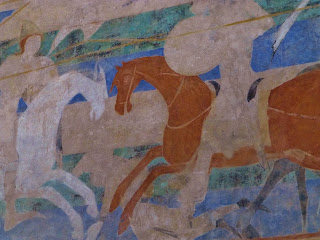Having taken
all our visitors over the last 2 years, to la cité, I admit to having become bored with
it. I had got to the stage of thinking that if any more of our family or
friends wanted to see it, they should go alone.
I had become
sick of the crowded streets, the plastic swords and shields on sale everywhere
, the poor quality food and even poorer quality service in restaurants that
know they are unlikely to see their clients again…so why bother to make any
effort at all.
 |
| The touristy show put on twice a day over the summer......attracting hundreds to each performance |
I had read
some of the tourist information and had thought that the 19th
century re-building of much of the city had turned it into a Disneyesque travesty
of what it had originally been.
I was wrong.
The plastic
swords are still there, the cassoulet quality does vary between establishments,
as does the service. However……it is unfair to accuse the 19th
century architect Viollet-le-Duc with the Disney sin.
Just delving a little deeper than the
immediately available tourist brochures, I discovered that apart from anything else,
Viollet-le-Duc’s work only affected about 20% of the buildings. I discovered
that there is much remaining evidence of building from Roman times, through to
the 5th century Visigoth phase, the brief Saracen occupation in the
8th century, and considerable proof of what was built when and how
from the 11th century Trencavel period, through the Albigesian
Crusade, the foundation of the bastide town, now the modern Carcassonne, and on
into the 19th century when Napoleon influenced things, removing its' military significance and finally
restoration work and recognition of the historical importance of the
fortifications over the previous 2 centuries.  |
| 12th century detail of a mural in the round room at the castle, depicting a battle between the Franks and the Saracens |
 |
| Roman items within the archeological museum inside the castle |
 |
| 12th century ablution fountain, again in the museum. Fractal flower image from a wonderful current exhibition where such images are put alongside antiquities. |
I knew I
loved the basilica St Nazaire, and not just because of the Russian singers I
have heard performing there on several of my visits. Now I know about the
original medieval glass, and the 12th century elements…I am
thrilled, and already looking forward to my next visit.
 |
| St Nazaire, from the ramparts |
 |
| just a glimpse of some of that glass |
I became
interested in the Trencavels last year when I learned about the Albigensian crusade,
the Beziers massacre of the Cathars in 1209 and the siege of Carcassonne in
August of the same year.
Apart from
playing such an important part in the crusade called by Innocent III to seize
lands held by Occitan Lords ( like Trencavel) who tolerated heresy ( in other
words…those who followed the “good men”, who preached equality, chastity,
humility, forbade murder, theft and lying, abstained from eating meat, accepted
death as deliverance and rejected symbols such as the cross ), Carcassonne has
been the fortress marking the border between Aragon and France. It was the 17th
century before the modern border between France and Spain was established,
removing this strategic role for Carcassonne.
The existing
buildings are much more authentic than I had realised. Little documentary evidence
about the various stages of building exist, but the actual stonework of the
different building phases, over 2 thousand years provides the evidence of its
continued development and importance over the centuries.
 |
| another image from the archeological museum |
The Disney
look is deceptive…..some of it has been re built, hoping to capture some of
what it might have looked like, but much of it is the result of change upon
change as different architectural styles developed and the needs of the
fortress city changed.
 |
| more fractal flowers.....especially for Annie. |
My next
visitors will be encouraged to see la cité, and I will love taking them there,
plastic armour and all.
 |
| Recognition of Carcassonne as a potential tourist destination, included using it as a backdrop for fireworks on Bastille day, way back in 1898. This photo is of the display in 2012. |

























































